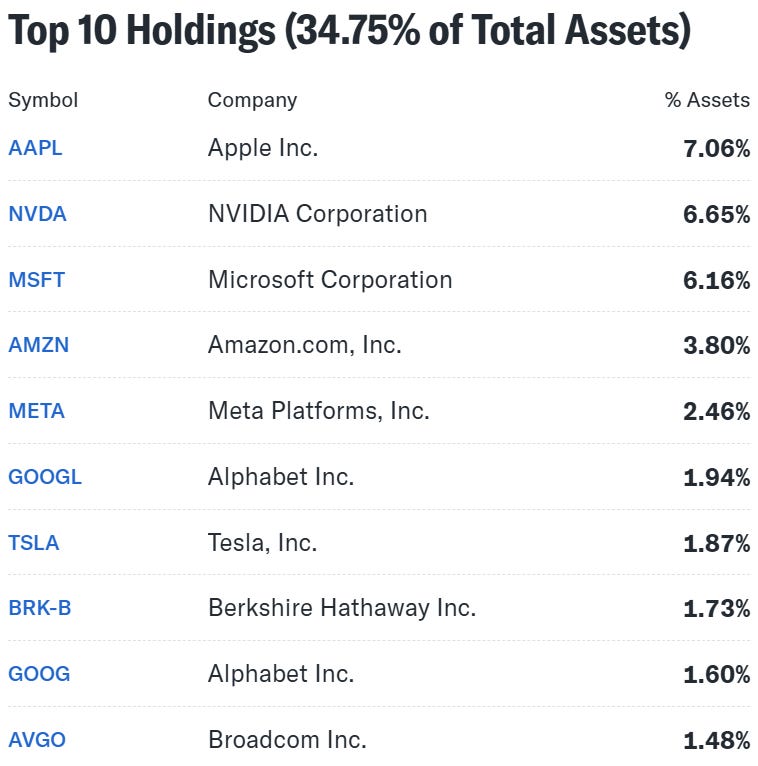Risks Of Passive Investing
Passive investing is simple and popular, but it’s not risk-free. Concentration in a few companies, distorted pricing, and liquidity risks are real concerns.
Most investors use index ETFs like SPY, VOO, or IVV, which follow the S&P 500 index. These ETFs are popular for passive investing, which aims to match the average market return over time. While this sounds simple and effective, there are some risks to consider.
Previous analysis:
A comprehensive analysis of Uber Technologies (UBER) is already available to patrons. Use the promo code UBER60 to get 60% off the first month of your subscription! Valid until the 28th of December.
Is There a Bubble in Passive Investing?
Michael Burry, known for predicting the 2008 mortgage crisis, warned about a possible bubble in passive investing. He says that over the last decade, index funds have grown too much. In fact, for the first time, passive funds managed more money than active funds. According to Morningstar, after steadily active funds’ dominance for years, passive funds closed 2023 with more assets. I believe the situation in 2024 will remain the same due to the popularity of passive investing. This rapid growth has created some serious risks.
One issue is the concentration of investments in just a few companies. For example, the top 10 companies in the S&P 500 make up over 34% of its total assets.
Apple alone represents 7% of the index’s weight, and together, these companies have a market capitalization of around $22.3 trillion. So, instead of spreading out risk, many passive portfolios are heavily weighted in just a few big tech companies. If these companies face problems, like a crash in the AI sector, the whole index could drop sharply. For instance, during the dot-com bubble burst in 2000, the Nasdaq 100 dropped by over 80%, pulling the broader S&P 500 down by more than 50%.
Distorted Share Pricing
Another risk is distorted pricing. When you buy an ETF, your money automatically goes to every company in the index, regardless of its performance. This means even companies with poor financials get investment. Over time, this weakens the natural supply-and-demand balance that usually sets stock prices.
As of the time of writing this publication, Vanguard, BlackRock, and State Street, the leading ETF providers, collectively own approximately 20% of Apple’s shares. This large ownership distorts price discovery, making it harder for markets to reflect the true value of stocks. Let’s compare this to the 2008 real estate bubble, where asset prices rose without real value backing them. At the moment the S&P 500’s price-to-earnings ratio is around 30, higher than its historical average of 16, suggesting overvaluation.
Liquidity Risks
A final issue is liquidity. If too many investors try to sell their ETF shares during a market crash, the funds might struggle to sell the underlying stocks. This could lead to extreme price drops or even the closure of some ETFs. For instance, during the March 2020 COVID-19 sell-off, the liquidity crunch in bond ETFs led to significant price gaps.
Additionally, passive funds now control over 50% of the U.S. equity market, up from 30% a decade ago. This dominance means that a sharp outflow could create systemic risks. In a worst-case scenario, panic selling could snowball, leading to regulatory interventions, halted trading, or forced liquidations of ETFs at extremely low prices.
Opinions of Famous Investors
Some well-known investors showed their concerns about passive investing. Joel Greenblatt, known for his "Magic Formula" investing strategy, argued that index investing ignores the fundamentals of individual companies. He believes that focusing only on the index as a whole can lead to mispriced stocks and poor capital allocation.
Similarly, Seth Klarman, author of "Margin of Safety," criticized the trend, calling it a "mindless" way of investing. He warns that passive strategies can create bubbles by driving money into overvalued stocks and leaving undervalued ones ignored.
Both investors emphasize the importance of active stock selection and understanding the true value of a business.
Conclusion
Passive investing is simple and popular, but it’s not risk-free. Concentration in a few companies, distorted pricing, and liquidity risks are real concerns. If you’re a passive investor, it’s important to understand these risks and think about how they might affect your portfolio in the future. While passive investing can offer low fees and long-term growth, it’s essential to stay aware of market conditions and ensure your portfolio is diversified beyond just a few dominant stocks. Actually, this is what we do here on Long-Term Pick - pick fundamentally good individual companies.
This is not a financial or investing recommendation. It is solely for educational purposes.
If you like the content, please hit the like icon, leave a comment, and share the publication with your friends and colleagues - this will motivate the author. If you're ready to support the project and get access to additional materials, visit this page.










Thanks for the very interesting read. In this context, what is your opinion on "quality ETFs"?
For investors who choose index funds due to limited time for research or risk tolerance, what alternatives would you recommend that maintain the simplicity of passive investing while addressing these concentration and valuation risks? Are there specific strategies or fund types that could offer a middle ground?